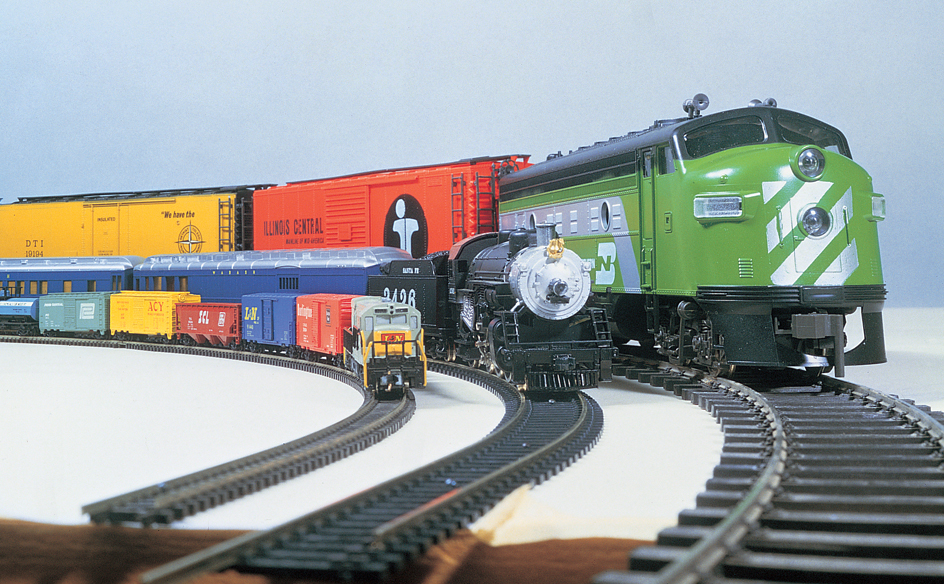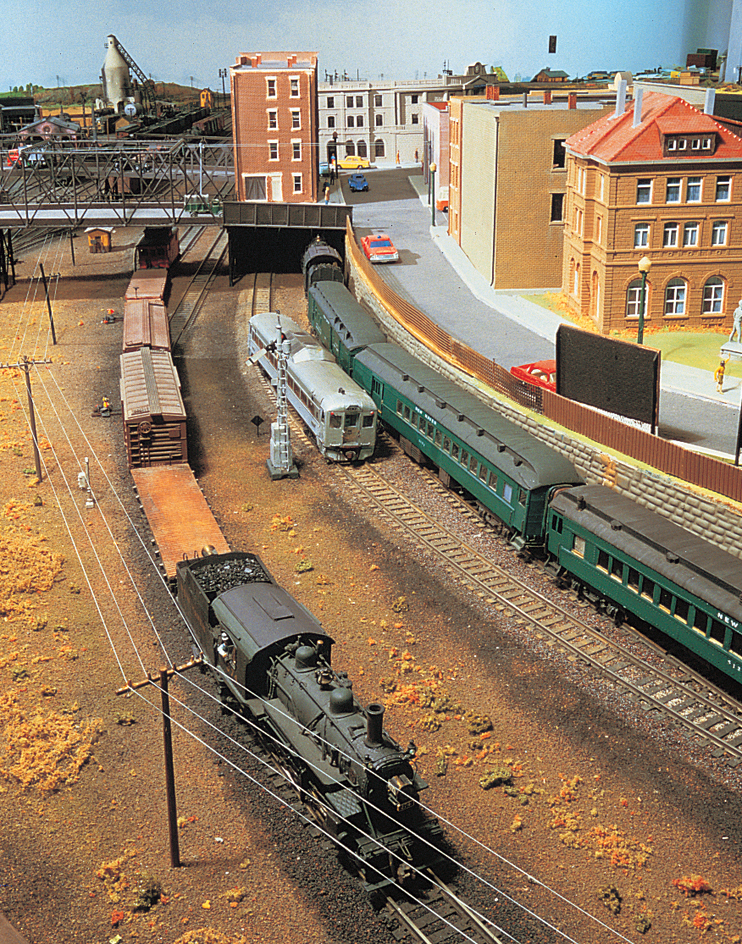Railroad, Model, is a small railroad that copies the appearance and operation of a full-sized railroad. Model railroading is the hobby of building and operating model railroads. It is a favorite pastime for thousands of people.
A model railroad can include all the major features of a real railroad, such as locomotives, cars, switches, signals, stations, and bridges. Hobbyists can also build miniature towns and natural scenery as settings. Model railroad cars, engines, and other equipment can be bought ready-made. But most model railroad enthusiasts enjoy designing and assembling their own systems. They build models from kits or make them from parts and raw materials. Model railroaders lay down tracks according to their own layout designs, and they wire their railroads to operate in a realistic way.

Model railroading offers a variety of activities in addition to modelmaking, such as carpentry, wiring electrical circuits, and making scenery. Model railroaders can concentrate on building only those parts of the system that they enjoy most, because the other parts can be purchased ready-made.
Model railroading differs from the hobby of operating toy trains. Model railroads are made to represent real trains in accurate detail. In building their systems, model railroaders copy as closely as possible the appearance and operation of a real railroad. Toy trains are larger than most model trains, and they are built to withstand rougher handling. Toy trains do not have much of the fine detail and realism that model trains have. Toy train enthusiasts may put together large and highly complicated railroad systems. However, most toy locomotives, cars, and other equipment are purchased completely assembled.
Scale and size.
Railroad models are built to scale. The scale is the comparison between the size of the model and the full-sized railroad, called the prototype. In the most common model railroad scale, called HO, each part of the model is 1/87 the size of the prototype. HO uses a gauge (track width) of 16.5 millimeters, or about 5/8 inch. This represents the standard track gauge of 4 feet 81/2 inches (1.44 meters) on a real railroad.
The most popular scale after HO is N scale, in which models are 1/160 the size of the prototype. N scale models run on N gauge tracks that are 9 millimeters, or about 1/3 inch wide. Most toy trains are built in O scale, which is 1/48 the size of the prototype. They run on O gauge tracks that are 11/4 inches (3.2 centimeters) wide.
A layout built in N scale will take up less space than the same layout in HO scale. But a modeler can build an N scale layout in a larger space and devote more of that space to scenery and buildings. A model railroad may cover as little as 9 to 12 square feet (0.8 to 1.1 square meters). Many are built on tabletops made from a plywood sheet measuring 4 feet (1.2 meters) wide and 8 feet (2.4 meters) long. Bigger systems can occupy most or all of a basement or attic. The largest scale is G scale. It is 1/22.5 of the prototype and is often used outdoors in garden railways. The smallest is Z scale, 1/220 the size of the prototype, and it can operate on a small layout.
Track
can be purchased in short sections or in longer flexible strips. Sectional track comes in straight or curved pieces, which are put together to form the desired layout. Sectional model railroad track resembles toy train track. But model railroad track has more ties per section so it looks more realistic. Flexible track, often called flextrack, comes in either 3-foot or 1-meter strips. The strips can be put down either straight or curved to fit the layout design. Some model railroaders buy rails separately and spike them down by hand on individual wooden ties for greater realism.
Most model railroads use the two rails to carry electrical current to and from the locomotive. The rails form the sides of an electrical circuit, and the locomotive completes the circuit through its wheels and motor. Some model railroads represent prototypes of electrically powered trains. Some of these models are powered through an overhead wire, as in a trolley car. Other models receive power through an outside third rail, as in the elevated and subway trains operating in many cities.
Toy trains have a third rail running down the middle of the tracks. This rail and the side rails carry current to and from the toy train locomotive.
Locomotives
for model railroads are purchased already assembled, or they are built from kits. Their power comes from household current that first passes through a separate electrical unit called a power pack. The power pack reduces the voltage of the household current from 110 volts to 12 volts. It also changes the type of current from alternating current, which continually reverses direction, to direct current, which flows in one direction. Most toy trains use alternating household current. The current first passes through a transformer that reduces the voltage. Both power packs and transformers include switches by which the operator controls the speed and direction of the locomotive.
Loading the player...Direct-current motor
Most model locomotives are made in one of two engine prototypes–steam or diesel.
Steam locomotives
are especially popular with model railroad enthusiasts, though they are no longer used on real railroads. A great variety of steam locomotives were custom built for different railroad companies. Each steam locomotive prototype has unique features that model builders value. Many hobbyists enjoy building steam locomotives because the locomotives have many visible moving parts. In a steam locomotive model, the motor is usually located in the firebox behind the boiler. A set of gears connects the motor to the axles of the large drive wheels.
Diesel locomotives
are simpler in appearance and easier to build than steam models. They are popular with hobbyists who want to create a more modern looking system. Diesel locomotive models have a more standard appearance than steam locomotives, but they have a variety of paint and lettering designs that represent the different railroad companies. Most diesel locomotive models have the motors in the middle of the body. The wheels are mounted on swiveling pieces called trucks attached to the bottom of the body. Gears connect the motor to the wheels of the locomotive. Many diesel models use two or more locomotive units to copy the makeup of real diesel locomotives. One of the model units might be a dummy, without motor or gears, which will still create the appearance of the real locomotive but at less expense.
Cars
for model railroads usually come in kits that can be assembled with a few simple tools. Most are made of plastic pieces that snap together. More challenging kits, called craftsman kits, include a combination of materials, such as wood, metal, and plastic. The pieces of the model must be cut to size and fitted together. In many kits, the cars are already painted with the designs of prototype railroads. In others, the model builders paint the cars themselves with their own designs. Some model builders combine parts from two or more kits, a practice that is called kitbashing.
Buildings and scenery.
Much of the realism of a model railroad depends on how creatively the builder designs the scenery of the system. The builder may send the train over a complicated route through tunnels and small towns, over rivers and highways, and into freight yards or passenger terminals.

There are a variety of kits for making buildings. Buildings can also be constructed from raw materials. Hobbyists build most scenery by shaping screen wire or cardboard webbing into the contours of hills, valleys, streams, and other landforms. They cover this shell with plaster. Builders then apply paint and texture materials to represent earth and grass, and add miniature trees and shrubs to complete the landscape.
Other systems and equipment
can be as simple or complex as the builder wishes. The basic wiring system for a model railroad allows only one train to run at a time. More complicated wiring permits several trains to run at once. Signals reproduce the functions of their prototype systems and add additional realism. Sound effects systems re-create the sounds of steam and diesel locomotives. Some hobbyists build working models of such equipment as drawbridges and coal dumpers. However, such accessories are more common in toy train systems. Advanced model railroaders may operate their railroad systems by radio control or by computer.
History.
Model railroading became a well-known hobby as a result of the model railroads shown at the Century of Progress Exposition in Chicago during 1933 and 1934. Public interest in these models encouraged manufacturers to produce model railroad kits and parts. In 1935, model railroad hobbyists and manufacturers organized the National Model Railroad Association to establish uniform standards for tracks, wheels, and other model railroad equipment.
In the early 1990’s, Model Railroader magazine estimated that about 250,000 adults operated model railroads as a hobby. Many belong to model railroad clubs. Members of clubs work as a group to build larger and more elaborate model railroads than they could do as individuals.
